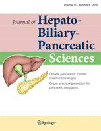Patient allocation based on preoperative assessment of pancreatic fibrosis to secure pancreatic anastomosis performed by trainee surgeons: a prospective study
Abstract
Background
A fragile or non-fibrotic pancreas increases the risk of postoperative pancreatic fistula (POPF) after pancreatic head resection, whereas pancreatic fibrosis decreases the risk. The degree of pancreatic fibrosis can be estimated using the time-signal intensity curve (TIC) of the pancreas, obtained with dynamic magnetic resonance imaging (MRI). We have investigated whether trainee surgeons can perform pancreatic anastomosis safely, without the occurrence of POPF, when patients are selected carefully based on a preoperative assessment of pancreatic fibrosis.
Methods
Seventy-two consecutive patients who underwent pancreatic head resection were enrolled in this prospective trial. Dynamic contrast-enhanced MRI of the pancreas was performed preoperatively in all patients who, based on their pancreatic TIC profile, were then allocated to one of two groups: Group A comprised patients with type I pancreatic TIC, signifying a normal pancreas without fibrosis (n = 46); Group B comprised patients with type II or III pancreatic TIC, signifying a fibrotic pancreas (n = 26). An end-to-side duct-to-mucosa pancreaticojejunostomy was performed in all patients, with all patients in Group A operated on by two experienced surgeons, and all patients in Group B operated on by one of eight trainee surgeons at various stages of training.
Results
There was no operative mortality. POPF developed in 19 patients: 12 patients with grade A POPF and seven with grade B. All except one of the POPF occurred in Group A patients. The POPF in the one patient from Group B was grade A (p < 0.001).
Conclusions
A trainee surgeon can perform a secure pancreatic anastomosis without the occurrence of POPF in patients with a pancreas displaying a fibrotic pancreatic TIC on dynamic MRI scans.




